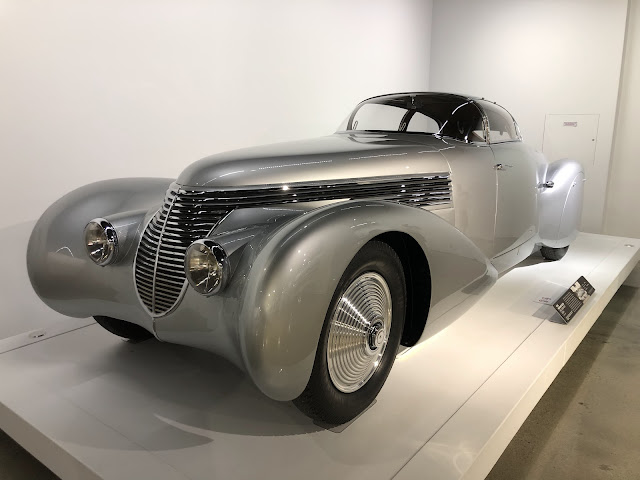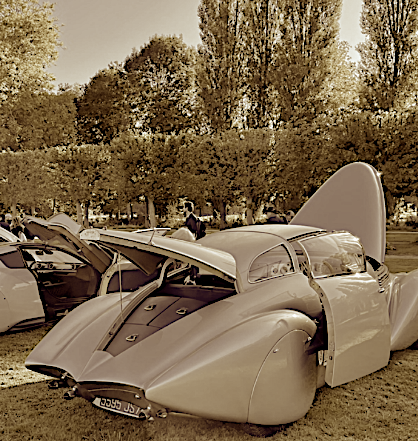This 1938 Xenia, built for aperitif mogul and inventor Andre Dubonnet on Hispano-Suiza's H6B chassis, may be unfamiliar to many (after all, there's only one), but may seem a bit like an old friend to frequent readers of this blog, because it's been featured here 5 times in the last 9 years*. We could have made it an even half dozen if we'd included it in our feature on the first modern car*, but we'd limited that roundup to production cars, loosely defined as cars made in at least 100 specimens. When, as the subtitle of that search suggested, we rounded up the usual suspects, Dubonnet's spectacular, futuristic Xenia got left out...
Though inheriting the aperitif business had provided him with influence, Dubonnet volunteered for service in what was supposed to be the war to end all wars, and was decorated for shooting down 5 German planes by war's end. Like fellow aviator and auto pioneer Garbriel Voisin, he was inspired to apply lessons from aviation to car design. He went to Jean Andreau, who'd also served in the French Air Service during WWI, to design something aerodynamic on his Hispano-Suiza chassis. They employed the streamlining from their Ford V8-powered Dolphin* of 1935, but not its rear midships engine location, dorsal fin, or the front-facing entry door that predicted the Isetta bubble car. They decided to use Dubonnet's Hyperflex coil-spring independent front suspension, which he'd licensed to firms like GM (which called it Knee Action) and Alfa Romeo, and applied it to the front and rear of the H6B chassis. Braking by hydraulically-operated aluminum drums was from the H6C, as was the engine, an aluminum block, 8 liter, SOHC inline six. The gearbox was by Hispano-Suiza, but with 4 speeds instead of their usual 3. What really stunned crowds at auto shows, though, was the car's light alloy body shell, formed by Jacques Saoutchik*. There were no straight lines in plan, section or elevation. Side windows curved into the roof. Doors were mounted on Saoutchik's favorite outrigger hinges so they could slide back parallel to the car. The windshield wrapped around the dash in a single, uninterrupted arc, predicting American wraparounds of the Fifties. In a long, tapered tail foreshadowing Le Mans streamliners, fitted luggage occupied the wedge-shaped trunk compartment...
Though Dubonnet, Andreau and Saoutchik were aware of the finned, teardrop-profile streamliners from the Czech Tatra company and French designers like Figoni and Pourtout, there was nothing in this period quite as futuristic as the Xenia, named after Dubonnet's wife, who had died in 1936.
 The front view is perhaps the most conventional one on the car, owing to the front location of the long, tall engine. The front fenders are integrated seamlessly into the front elevation, emerging at the sides as separate teardrop forms. At the rear, though, fenders merge into the car's flanks aft of the doors, anticipating the forms of Bonneville speed record cars and endurance road racers.
The front view is perhaps the most conventional one on the car, owing to the front location of the long, tall engine. The front fenders are integrated seamlessly into the front elevation, emerging at the sides as separate teardrop forms. At the rear, though, fenders merge into the car's flanks aft of the doors, anticipating the forms of Bonneville speed record cars and endurance road racers. Reviewers have noted the aircraft influence on the transparent bubble of the greenhouse. The only problem with this analysis is that only top secret airplanes looked like this when the car was designed in 1937. In sketching out these plexiglas curves, Dubonnet and Andreau seemed to be anticipating the first jets, which would first fly 2 years later, as war again descended on Europe.
Instruments and switchgear were arranged in linear fashion across the curved dash. Steering was on the right, as on most upper-crust French cars during this period, though popular cars like Citroens were LHD. This view shows the transparency of the forward view from the cockpit, better than modern cars with their foam-padded A pillars. Xenia was hidden soon after the Nazi invasion, and only appeared again in 1946 for a parade. Purchased postwar by a French Hispano collector, she eventually landed in Peter Mullin's collection in Los Angeles, and is now at the Petersen Automotive Museum in the same city...
Before the present century was 2 decades old, a modern Hispano-Suiza revival was launched in Barcelona, focused on the all-electric Carmen, named for the granddaughter of the original company's founder. The rear view is the car's best, and emulates the pointed deck and skirted rear wheels of the Xenia. Like the Xenia, it provides plenty of torque; electrics offer up all their torque when you first press the accelerator. But Carmen really excels in the horsepower department, with over 6 times the Xenia's 160. Like the Xenia which allegedly inspired it, the Carmen is not cheap, with a price of $1.7 million for the coupe, while the Boulogne roadster goes for $1.9 million. Plans call for 2 dozen cars in total. It remains to be seen whether the launch of this electric supercar reflects the same kind of overoptimism that surrounded the Xenia, which, like the Carmen, was launched as clouds of war began to drift into the skies over Europe...
*Footnote: Xenia's first appearance here was on Sept. 7, 2015, in "One of One: A Brief History of Singular Cars"; the second was in "Roadside Attraction: Rolling Sculpture at the North Carolina Museum of Art" on Dec. 31, 2016. Xenia appeared again in "Hispano-Suiza: Swiss Precision, Spanish Drama, French Style" on Sept. 25, 2017, and was included in an overview of coachbuilder Jacques Saoutchik's work on March 8, 2020 in "The French Line Part 4: Jacques Saoutchik---A Talent for Overstatement". And a survey of candidates for the honor of first modern car appeared without the Xenia on Sept. 26, 2020, entitled "The First Modern Car? Round Up the Usual Suspects..." The 1935 Dolphin designed by Dubonnet and Andreau is interesting enough to get its own post, and that will happen soon.
Photo Credits
All color photos: Art Heinrich
Monochrome photos (3rd and bottom): hispanosuizacars.com







Great Post, fantastic car!
ReplyDeleteThanks for having a look, Lewis. Now we need to track down photos of the '35 Dubonnet Dolphin prototype, along with following the trail to the source on those '70 Paris Auto Salon photos you liked.
ReplyDelete